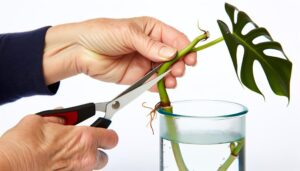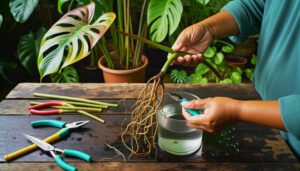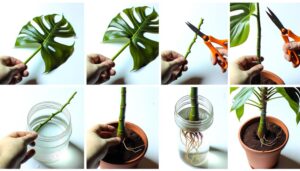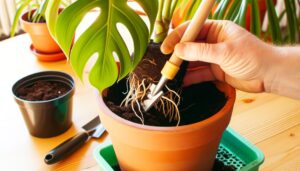How to Propagate Monstera: Do I Let It Callous?
Yes, you should let Monstera cuttings callous before planting. Start by making a clean cut below a node with sterilized pruning shears.
Place the cutting in a dry, well-ventilated area away from direct sunlight. Allow 3-5 days for the cut end to form a callous, which aids in preventing pathogen entry and moisture loss.
Once calloused, plant the cutting in well-draining potting mix. Ensure the node is submerged, water thoroughly, and maintain indirect sunlight and suitable humidity.
This process reduces rot risk and promotes healthy root development. For more detailed steps and tips, further information is available.
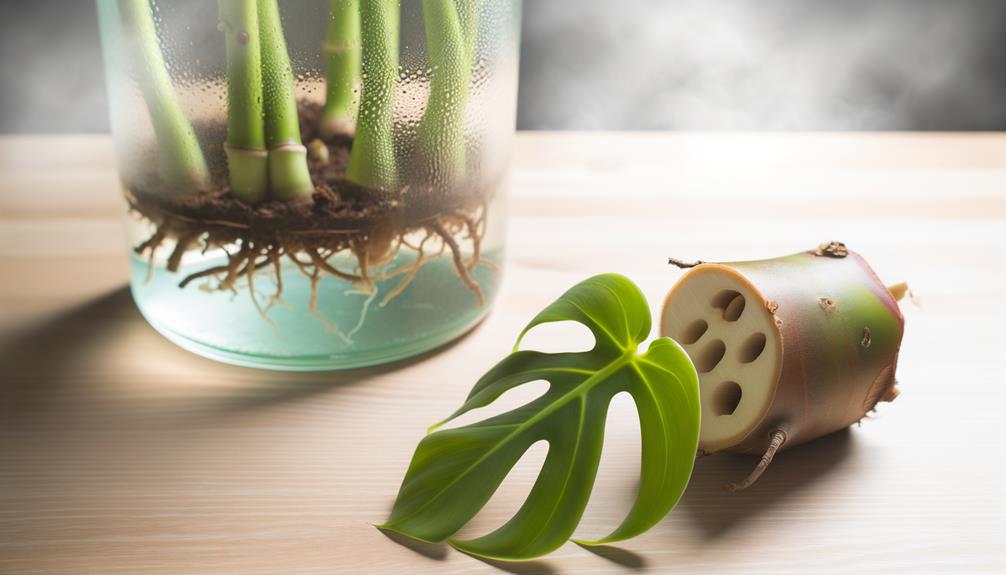
Key Takeaways
- Allow cut ends to callous for 3-5 days in a dry, well-ventilated area with indirect sunlight.
- Callousing forms a protective layer to prevent pathogen entry and reduce moisture loss.
- Ensure cuts are clean and below the nodes to promote successful propagation and root development.
- Sterilize tools and monitor humidity levels during the callousing process to prevent rot.
- After callousing, plant cuttings in well-draining soil and maintain optimal growing conditions.
Understanding Monstera Propagation
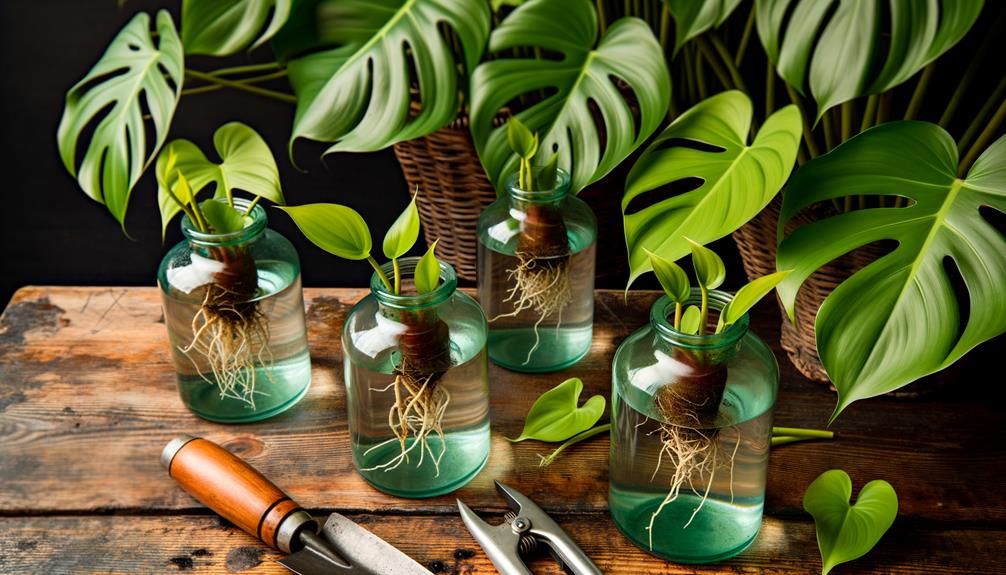
Monstera propagation involves the intentional process of creating new plants from stem cuttings, utilizing their natural ability to regenerate.
You’ll start by identifying a healthy mother plant. Locate a section of the stem with at least one node and an aerial root. Using sterilized pruning shears, make a clean cut just below the node. The node is essential as it contains meristematic tissue, which is responsible for new growth.
After cutting, place the stem in a well-ventilated area to allow the cut end to callous over. This step helps prevent rot when you eventually plant the cutting.
Monitor the cutting closely, ensuring it’s kept in ideal conditions for successful propagation. Properly executed, this process guarantees healthy new Monstera plants.
Necessary Tools and Materials
To propagate your Monstera, you’ll need a few essential tools and materials.
Gather a sterilized pruning shear, rooting hormone, and a clean container filled with a well-draining potting mix.
Make sure you have gloves and rubbing alcohol for sanitation purposes.
Essential Tools and Materials
Gathering the appropriate tools and materials, such as a sharp, disinfected pruning shears and a hygienic cutting board, guarantees a successful Monstera propagation process. First, make sure your pruning shears are sanitized using isopropyl alcohol to prevent bacterial contamination.
A hygienic cutting board provides a sterile surface for making precise cuts. You’ll also need a glass jar filled with filtered water for rooting the cuttings. Prepare a propagation medium, such as sphagnum moss or perlite, to support root development.
Additionally, use rooting hormone powder to stimulate faster root growth. Finally, have a spray bottle of distilled water on hand to maintain humidity levels around the cuttings. Proper preparation with the right tools and materials ensures optimal propagation conditions.
How to Propagate Monstera Do I Let It Callous
Before you begin the propagation process, make certain you let the cut ends of your Monstera cuttings callous over for at least 24 hours to prevent rot and promote healthier root development.
You’ll need sharp, sterilized pruning shears to make clean cuts, reducing the risk of bacterial infection.
Use a clean container filled with distilled or dechlorinated water to promote root growth. For a more controlled environment, consider using a propagation station or clear plastic bag to maintain humidity.
Additionally, you’ll need a rooting hormone to encourage faster root development. Don’t forget to have a well-draining potting mix and a small pot ready for when roots emerge.
Preparing Your Tools and Environment
Make certain you have all necessary tools and materials ready, including sharp, sterilized trimming shears, distilled or dechlorinated water, a spotless container, a rooting hormone, a propagation station or clear plastic bag, well-draining potting mixture, a small pot, and access to indirect sunlight.
Start by sterilizing your trimming shears to prevent infections. Use distilled or dechlorinated water to avoid chlorine damage to new roots.
A spotless container is vital for holding cuttings. Rooting hormone enhances root development. A propagation station or clear plastic bag maintains humidity. Well-draining potting mixture prevents root rot.
Choosing a Healthy Stem
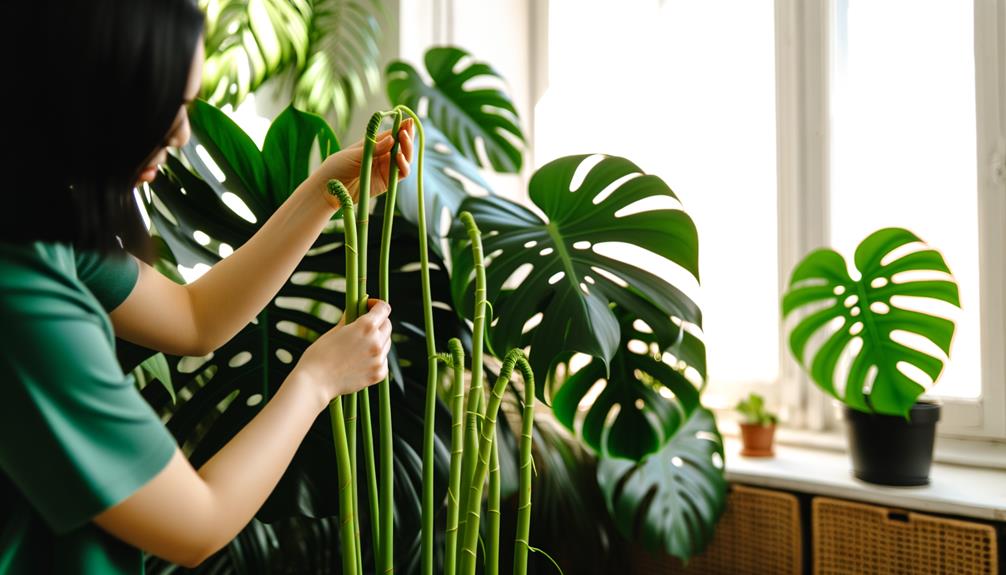
Select a stem with at least one node and a few healthy leaves, making sure it’s free from pests and diseases. This is important for successful propagation.
Look for a stem that exhibits vigorous growth and has a vibrant green color, indicating good health. Avoid stems with yellowing leaves, spots, or signs of distress.
- Node Identification: Verify the stem has a visible node, as this is where roots will develop.
- Leaf Health: Choose stems with at least two fully-formed, healthy leaves.
- Disease-Free: Inspect for any signs of pests, fungal infections, or rot.
- Stem Thickness: Opt for a stem that’s neither too thin nor too thick.
- Growth Vigor: Select a stem from a part of the plant showing active growth.
Careful selection maximizes propagation success.
Making the Cut
When you’re ready to make the cut, use a sanitized, sharp blade to guarantee a clean slice through the stem just below a node. This node is essential because it contains meristematic cells that will develop into roots.
Verify your blade is sanitized with isopropyl alcohol to prevent introducing pathogens. Aim for a precise 45-degree angle cut to maximize the surface area for rooting. Avoid crushing the stem, which could impede water uptake and root formation.
Hold the stem steady and make a swift, decisive cut. Immediately place the cutting in a clean, dry area to prevent contamination. Don’t rush this step; precision is key for successful propagation.
Now, you’re ready to move on to the next phase.
What Is Callousing?
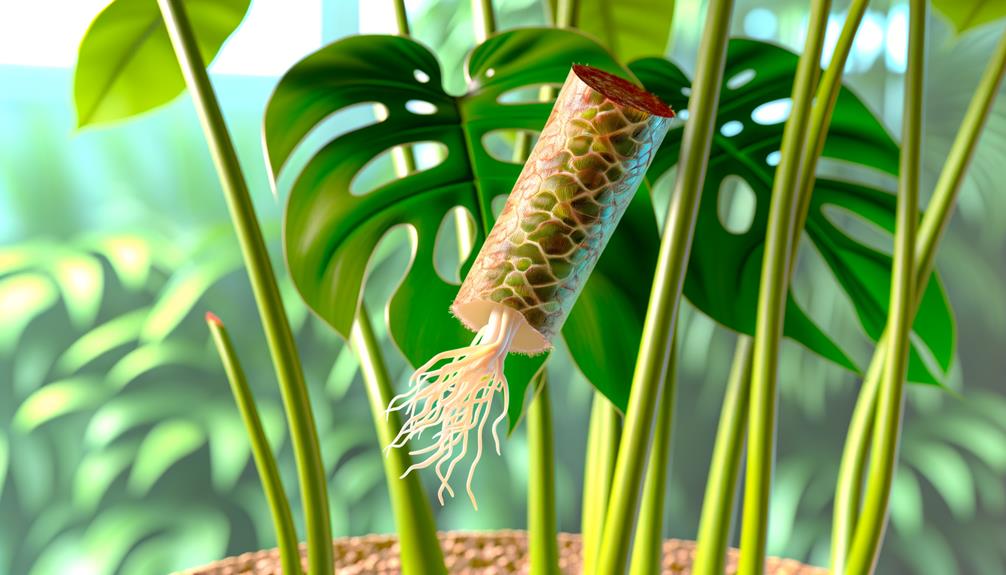
Callousing refers to the formation of a protective layer of tissue over the cut end of a plant stem, essential for successful propagation.
You’ll notice this process as the exposed area dries and hardens, preventing pathogen entry and moisture loss.
Understanding callousing‘s role in plant healing and root development is pivotal for effective Monstera propagation.
Definition of Callousing
In the context of propagating Monstera, callousing refers to the necessary process where a cut end of the plant forms a protective layer of tissue before it’s planted. This layer, known as a callus, acts as a barrier against pathogens and helps in root formation.
To achieve proper callousing, follow these detailed steps:
- Identify the node: Confirm the cut includes a node, the point where new roots will develop.
- Make a clean cut: Use sterilized scissors to prevent infection.
- Air-dry the cutting: Let the cut end dry in a well-ventilated area for 24-48 hours.
- Monitor the callus: The cut should feel dry and slightly hardened.
- Avoid direct sunlight: Place the cutting in indirect light to prevent damage.
Importance in Propagation
To secure successful propagation, you must understand that callousing is important because it prevents pathogen entry and aids in root development. When you cut a Monstera stem, the wound is susceptible to bacterial and fungal infections.
Allowing the cut end to callous creates a protective barrier, minimizing the risk of pathogens infiltrating the plant tissue.
This callous formation also facilitates the differentiation of plant cells into root cells. Without a proper callous, roots may not form efficiently, leading to suboptimal propagation outcomes.
Make sure you allow the cuttings to callous in a dry, well-ventilated environment. This process typically takes a few days, depending on humidity and temperature conditions, establishing the stage for robust root growth and healthy new plants.
How Callousing Occurs
When you trim a Monstera stem, the plant starts a healing process where cells at the wound site begin to dry and harden, forming a protective layer known as callous. This callousing process is essential for successful propagation.
- Cellular desiccation: The cells release excess water, decreasing vulnerability to pathogens.
- Wood formation: Cell walls thicken with lignin, providing structural support and defense.
- Suberin formation: A waxy substance creates a barrier, restricting water loss and microbial invasion.
- Plant hormone alterations: Hormones like auxin and cytokinin regulate healing and root initiation.
- Oxygen burst: Reactive oxygen species (ROS) are generated, discouraging infections and signaling repair mechanisms.
Comprehending these steps guarantees you handle the process effectively, promoting healthy root development and improving propagation success.
Benefits of Callousing
Allowing the cut end of a Monstera stem to callous promotes tissue healing and reduces the risk of rot, ensuring a healthier propagation process.
When the cut end is exposed to air, a protective layer forms over the wound. This callous tissue acts as a barrier, preventing pathogens from entering and causing infections.
By avoiding immediate placement in water or soil, you let the cut surface dry and harden, which minimizes water loss and cellular damage. Additionally, the callousing process encourages the formation of root primordia, essential for successful root development.
How to Let Cuttings Callous
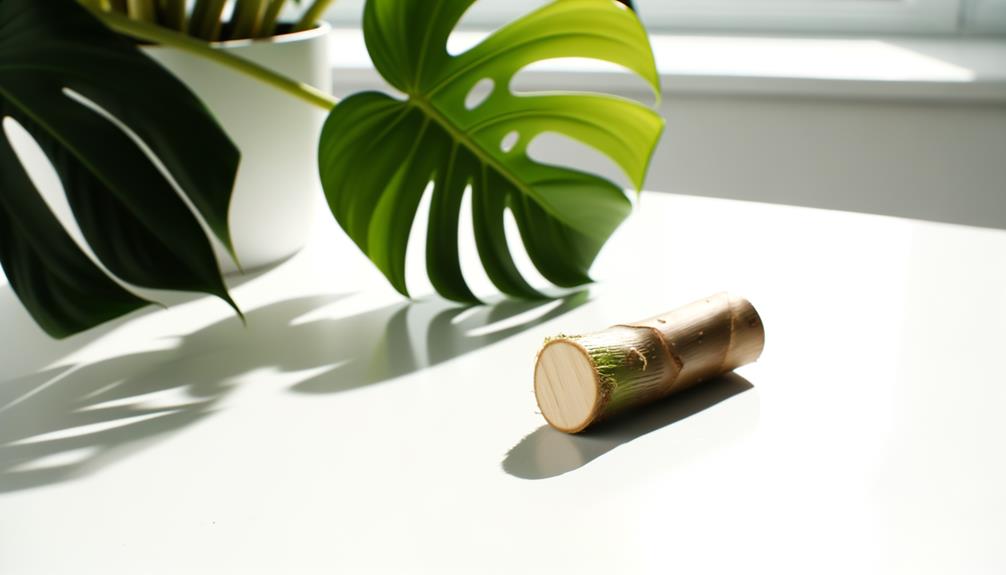
Begin by making a clean cut on the Monstera stem using sterilized pruning shears to prevent contamination. After cutting, place the stem cutting in a dry, well-ventilated area away from direct sunlight.
The objective is to allow the cut end to callous, forming a protective layer that guards against pathogens and desiccation.
- Sterilize tools: Use rubbing alcohol or a bleach solution.
- Dry location: Choose a spot with good airflow.
- Avoid direct sunlight: Prevent sunburn on the cutting.
- Monitor humidity: Ideal humidity levels are around 50-60%.
- Timeframe: Allow 3-5 days for callousing.
You’ll notice the cut end hardening and changing texture, indicating successful callousing. This process is pivotal for the next propagation steps.
Planting the Calloused Cutting
To plant the calloused cutting, first prepare a well-draining planting medium composed of equal parts potting soil, perlite, and orchid bark.
Position the cutting so that the node is submerged in the medium, ensuring proper contact for root development.
Water the medium thoroughly, then maintain consistent moisture levels, avoiding waterlogging to prevent root rot.
Prepare the Planting Medium
Ensure the planting medium is well-draining by mixing equal parts of perlite, orchid bark, and high-grade potting soil. This combination guarantees ideal aeration and moisture retention, vital for root development.
Each component serves a distinct purpose:
- Perlite: Enhances drainage and prevents compaction.
- Orchid bark: Provides structural integrity and air pockets.
- High-grade potting soil: Supplies essential nutrients and retains moisture.
Mix these thoroughly to create a homogeneous medium. Guarantee the container has sufficient drainage holes to avoid waterlogging, which can cause root rot. Sterilize the container and tools to prevent pathogen introduction.
Maintain a slightly acidic to neutral pH (5.5-7.0) for optimal growth conditions. Your Monstera cutting will thrive in this scientifically balanced environment.
Position the Cutting Correctly
Place the calloused Monstera cutting into the prepared planting medium, making certain the node where the roots will develop is buried about an inch deep.
Position the cutting so that the aerial roots, if any, are in contact with the soil. Maintain a vertical orientation to facilitate proper growth.
Firmly press the medium around the base of the cutting to eliminate air pockets, enhancing root contact. Guarantee the medium remains loose enough to allow for adequate aeration and drainage.
You should avoid placing the cutting too deep, as this can lead to rot. Instead, a shallow planting depth encourages healthier root formation.
Monitor the cutting for stability; it shouldn’t wobble or tilt, as this could impede root establishment.
Water and Maintain Regularly
After positioning the cutting, water the soil thoroughly to make certain it’s evenly moist but not waterlogged, promoting ideal conditions for root development. Use a well-draining potting mix rich in organic matter to support nutrient uptake. Make sure the pot has drainage holes to prevent root rot.
Maintain humidity levels around 60-70% by misting or using a humidity tray. Place the pot in a location with indirect sunlight to prevent leaf burn while providing sufficient light for photosynthesis.
Monitor the cutting for signs of growth, such as new leaves or root development, and adjust care as needed.
- Use a moisture meter to prevent overwatering.
- Opt for filtered water to avoid mineral build-up.
- Rotate the pot for even light exposure.
- Prune dead leaves to promote growth.
- Check for pests regularly.
Optimal Growing Conditions
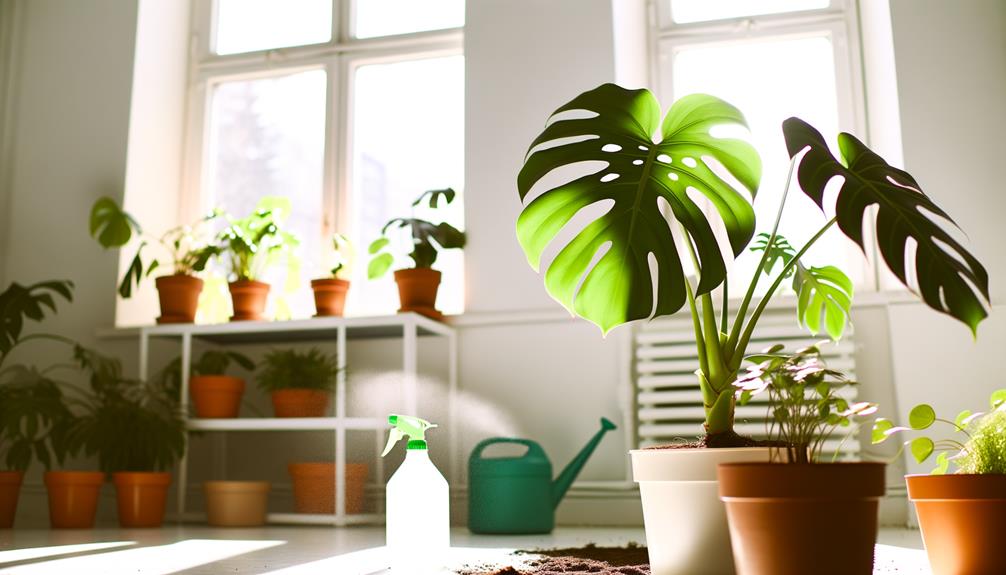
To ensure your propagated Monstera thrives, provide it with indirect sunlight, maintaining a temperature range between 65-85°F and humidity levels above 60%.
Maximize filtered light by placing the plant near a north or east-facing window, using sheer curtains if necessary. Monstera plants require well-draining soil with a pH between 5.5-7.0 to avoid root rot.
Use a balanced, water-soluble fertilizer, applying it at half-strength every 4-6 weeks. Hydrate the plant when the top inch of soil feels dry, ensuring thorough watering while preventing waterlogging.
You can use a humidity tray or a humidifier to maintain peak moisture levels. These conditions replicate its native tropical environment, promoting robust growth and leaf development.
Caring for New Monstera Plants
Once your Monstera cuttings are established in ideal conditions, focus on specific care practices to support their development into healthy, mature plants. Make sure you provide consistent moisture, but avoid waterlogging the roots, which can lead to root rot.
Maintain a high humidity environment, around 60-70%, to mimic their natural habitat.
- Light: Provide bright, indirect sunlight to facilitate photosynthesis without scorching the leaves.
- Soil: Use a well-draining potting mix containing peat, perlite, and orchid bark to guarantee aeration.
- Watering: Water when the top inch of soil feels dry, ensuring uniform moisture distribution.
- Fertilization: Apply a balanced liquid fertilizer every 4-6 weeks during the growing season.
- Pest Control: Monitor for common pests like spider mites and treat immediately with neem oil or insecticidal soap.
Conclusion
You’ve got the keys to successfully propagate your Monstera. By understanding the process, gathering the right tools, and letting the cuttings callous, you’re setting the stage for healthy growth.
Think of it as nurturing a tiny green phoenix, rising from its ashes. With ideal conditions and diligent care, your new Monstera plants will thrive.
Remember, patience and precision are your best allies in this botanical journey. Happy propagating!

